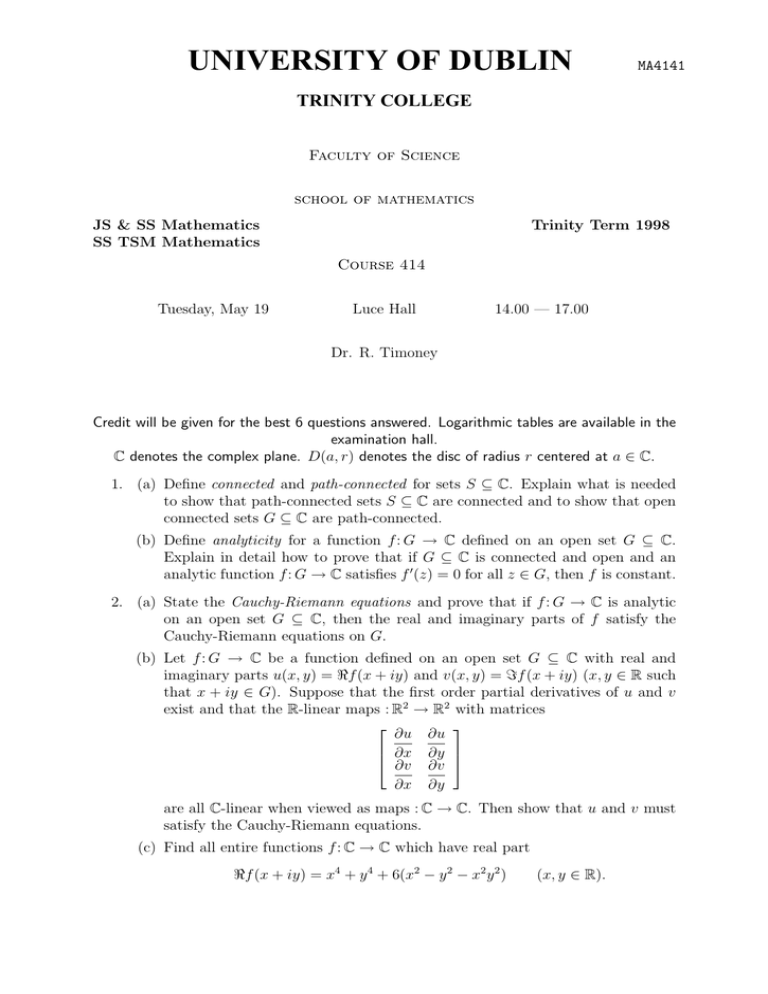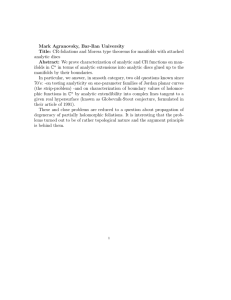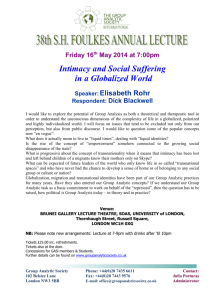UNIVERSITY OF DUBLIN TRINITY COLLEGE
advertisement

UNIVERSITY OF DUBLIN
MA4141
TRINITY COLLEGE
Faculty of Science
school of mathematics
JS & SS Mathematics
SS TSM Mathematics
Trinity Term 1998
Course 414
Tuesday, May 19
Luce Hall
14.00 — 17.00
Dr. R. Timoney
Credit will be given for the best 6 questions answered. Logarithmic tables are available in the
examination hall.
C denotes the complex plane. D(a, r) denotes the disc of radius r centered at a ∈ C.
1. (a) Define connected and path-connected for sets S ⊆ C. Explain what is needed
to show that path-connected sets S ⊆ C are connected and to show that open
connected sets G ⊆ C are path-connected.
(b) Define analyticity for a function f : G → C defined on an open set G ⊆ C.
Explain in detail how to prove that if G ⊆ C is connected and open and an
analytic function f : G → C satisfies f 0 (z) = 0 for all z ∈ G, then f is constant.
2. (a) State the Cauchy-Riemann equations and prove that if f : G → C is analytic
on an open set G ⊆ C, then the real and imaginary parts of f satisfy the
Cauchy-Riemann equations on G.
(b) Let f : G → C be a function defined on an open set G ⊆ C with real and
imaginary parts u(x, y) = <f (x + iy) and v(x, y) = =f (x + iy) (x, y ∈ R such
that x + iy ∈ G). Suppose that the first order partial derivatives of u and v
exist and that the R-linear maps : R2 → R2 with matrices
∂u ∂u
∂x ∂y
∂v ∂v
∂x ∂y
are all C-linear when viewed as maps : C → C. Then show that u and v must
satisfy the Cauchy-Riemann equations.
(c) Find all entire functions f : C → C which have real part
<f (x + iy) = x4 + y 4 + 6(x2 − y 2 − x2 y 2 )
(x, y ∈ R).
2
MA4141
3. (a) State the homotopy version of Cauchy’s theorem. Explain the terminology
involved.
(b) Define index (or winding number) of a closed curve γ in C about a point in C.
What hypotheses are needed for the curve and the point?
(c) Define what it means for a set G ⊆ C to be simply connected. If G ⊆ C is
open and simply connected, show that any analytic function f : G → C has an
antiderivative. (State any results you use.)
4. (a) Give the definition of a branch of the logarithm of an analytic function. Show
that if there is a branch of the logarithm for an analytic function f : G → C,
then f is never zero on G and also that there is an antiderivative for f 0 (z)/f (z)
on G.
(b) Give an example (with proof) of an analytic function f (z) which is never zero
on its domain but where no branch of the logarithm of f exists. What property
of the domain of f is essential for this example to work?
(c) Let f : G → C be analytic and nonconstant on a region G ⊆ C. If f has an
analytic nth -root on G for each n = 1, 2, . . ., show that f is never zero on G
and that there is a branch of the logarithm of f on G.
5. (a) State the maximum modulus principle for analytic functions.
(b) If f : G → C is analytic on a region G ⊆ C and a ∈ G is a local minimum point
for |f (z)| show that either f (a) = 0 or f is constant.
(c) If f : G → C is analytic and nonconstant on a region G ⊆ C show that <f (z)
has neither a local minimum nor a local maximum point in G.
6. (a) Show that if an analytic function f (z) has an isolated singularity at z = a,
then f (a) can be defined (or redefined) to make f analytic at a if and only if
lim (z − a)f (z) = 0.
z→a
(b) Define what is meant by a pole and an essential singularity for an analytic
function. Explain how removable singularities, poles and essential singularities can be distinguished by the behaviour of f (z) nearby. Give examples of
analytic functions with poles and essential singularities (with justifications).
(c) Define the notion of a meromorphic function and explain how meromorphic
functions give rise to an analytic function with values on the Riemann sphere
ˆ = C ∪ {∞}.
C
7. (a) Define uniform convergence on compact subsets for sequences of analytic functions on an open set G ⊆ C.
(b) Explain how to introduce a metric ρ on the space H(G) of all analytic functions
on an open set G ⊆ C in such a way that convergence in (H(G), ρ) corresponds
to uniform convergence on compact subsets of G.
(c) Explain how the space (H(G), ρ) can be shown to be a complete metric space
for ρ as in part (b).
3
MA4141
8. (a) State Montel’s theorem and explain the terminology involved.
(b) State the Arzela-Ascoli theorem and use it to prove Montel’s theorem.
(c) Prove that if a sequence (pn (z))∞
n=1 of polynomials converges pointwise on C
to a function f : C → C with a discontinuity at 0, then
lim sup |pn (z)| = ∞.
n→∞ |z|≤1
9. (a) Prove that there is a continuous linear functional α on (H(D(0, 1)), ρ) (where
ρ is as in question 7, part (b)) which has α(z n ) = n!1 for n = 0, 1, 2, . . ..
(b) State Runge’s theorem. Show that there is a sequence (pn (z))∞
n=1 of polynomials
with
lim sup |pn (z)| = 0 and lim sup |pn (z) − 1| = 0.
n→∞ |z|≤1
n→∞ |z−3|≤1
10. (a) State and prove Hurwitz’s theorem.
(b) State the Schwarz lemma.
(c) State the Riemann mapping theorem.
c UNIVERSITY OF DUBLIN 1998

![Mathematics 414 2003–04 Exercises 1 [Due Tuesday October 28th, 2003.]](http://s2.studylib.net/store/data/010415762_1-9e53d350b0430ad1e5431d2ba3c48759-300x300.png)
![Mathematics 414 2003–04 Exercises 5 [Due Monday February 16th, 2004.]](http://s2.studylib.net/store/data/010415766_1-b65af2bb66ab8e422354912dcedcb6a6-300x300.png)


![Mathematics 414 2003–04 Exercises 4 [Due Monday February 2nd, 2004.]](http://s2.studylib.net/store/data/010415765_1-b159664fbd982cf95e1ae146093d034c-300x300.png)
![Mathematics 414 2003–04 Exercises 3 [Due Monday January 5th, 2004.]](http://s2.studylib.net/store/data/010415764_1-3f4084aa6eb8e046b7be83fab4c2a801-300x300.png)

